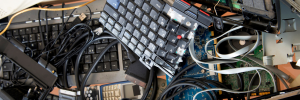Reducing electronic waste at SU
- 14 October is International E-Waste Day.
- Secure recycling of outdated hardware to reduce e-waste.
- Encouraging digital decluttering and responsible data management.
Every year, the world generates around 40 million tons of electronic waste (e-waste) - the equivalent of throwing away 800 laptops every second (according to The World Counts). As the digital landscape continues to expand, so does the need to manage digital waste responsibly.
At Stellenbosch University (SU), the Information Technology (IT) Division is actively working towards more sustainable practices by finding practical ways to reduce e-waste, while supporting the University’s broader commitment to sustainability. Clive Layman, a technical support specialist from the End User Support team in IT, explains that IT does not work in isolation when addressing e-waste; it collaborates with departments across campus.
“When equipment reaches the end of its usable life, the IT Division helps departments dispose of it correctly. This involves ensuring equipment is decommissioned securely and then properly recycled or repurposed,” he says.
Old hardware, such as computers, hard drives and memory, is handled through secure processes. Hard drives are removed and physically destroyed to protect sensitive data. A specialised company collects these components, using tools like hammers and piercing devices to render the drives unreadable before sending them for secure recycling. This process ensures that sensitive data cannot be recovered and that e-waste stays out of landfills.
Students and staff can also use the yellow bins available at the IT HUB and the ICT main building in Hammanshand Road for smaller items such as batteries, used phones or other small electronic devices. Staff members may also bring old electronic equipment from home to the ICT building for proper disposal.
In collaboration with SU’s Environmental Sustainability Department, the IT Division also supports regular e-waste drop-off drives across campuses. These drives provide an opportunity for staff and students to safely dispose of non-SU electronic items such as personal laptops, cell phones and other small devices.
With the introduction of new operating systems such as Windows 11, the IT Division often evaluates older devices brought in for upgrades. In some cases, older laptops may not meet the minimum system requirements to run newer software efficiently. Before proceeding with an upgrade, the team considers factors such as the device’s age, performance expectations and replacement costs.
If a device is unlikely to handle the new software effectively, the IT team may recommend replacing it rather than upgrading. This not only ensures a better user experience but also prevents unnecessary digital waste by keeping outdated hardware in use.
“Just because an older laptop can be upgraded doesn’t mean it should be,” says Layman. “Continuing to use a device that struggles with newer software leads to inefficiencies, frustration and often a shorter lifespan. We help users make informed decisions to avoid these pitfalls.”
Beyond physical hardware, the IT Division is also addressing digital clutter - or data waste. Departments and individuals are encouraged to regularly clean up digital storage by deleting old or unnecessary files, backing up critical data securely, and avoiding redundant copies.
Staff and students are guided to remove old files when systems and devices are decommissioned, and to back up important data in secure locations. In some cases, departments have neglected to secure data properly before writing off equipment, highlighting the importance of awareness and communication around digital responsibility.
Whether you are a staff member or student, you can help reduce digital waste by:
- Regularly decluttering your digital storage,
- Disposing of old devices through the proper channels, and
- Being mindful about what you save and for how long.
Through collaboration and awareness, the IT Division’s goal remains clear: to reduce e-waste and handle university resources responsibly and securely - one hard drive, upgrade and file at a time.

